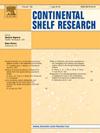Association between selenium levels and the distribution of mangrove forests in the brackish water exchange zone of the Pearl river estuary
IF 2.2
3区 地球科学
Q2 OCEANOGRAPHY
引用次数: 0
Abstract
Mangroves are vital coastal wetland system widely distributed in tropical and subtropical intertidal zones around 30° latitude. In most coastal ecosystems, plant growth is generally inhibited by salinity. However, mangroves thrive in brackish coastal areas. Previous studies have shown that mangrove distribution is strongly influenced by seawater, likely due to its chemical composition and role in global biogeochemical cycles. Seasonal variations in salinity and selenium (Se) levels in coastal regions exhibit similar patterns, and low doses of supplemental Se can protect plants against reactive oxygen species (ROS)-induced oxidative damage. This study focused on the Pearl River Estuary to examine the relationship among Se content, salinity, and mangrove distribution. Clear seasonal fluctuations in Se levels were observed in the estuary. Se concentrations in the estuary were significantly higher than the average level due to runoff. Dissolved inorganic selenium (DISe) decreased with increasing distance from the estuary. Results revealed a significant positive correlation between mangrove distribution and Se content (p < 0.05), whereas no significant relationship with salinity was found. Furthermore, Se application enhanced mangrove tolerance to salt stress-induced oxidative damage by strengthening antioxidant defense systems. These findings provide valuable insights for the conservation and management of mangrove ecosystems.
珠江口咸淡水交换带红树林硒含量与分布的关系
红树林是重要的滨海湿地系统,广泛分布于30°左右的热带和亚热带潮间带。在大多数沿海生态系统中,植物生长通常受到盐度的抑制。然而,红树林生长在咸淡海岸地区。以前的研究表明,红树林的分布受到海水的强烈影响,可能是由于海水的化学成分和在全球生物地球化学循环中的作用。沿海地区盐度和硒(Se)水平的季节性变化具有相似的模式,低剂量硒的补充可以保护植物免受活性氧(ROS)诱导的氧化损伤。本文以珠江口为研究对象,探讨了硒含量、盐度与红树林分布的关系。河口硒含量有明显的季节波动。由于径流的影响,河口硒含量明显高于平均水平。溶解无机硒(DISe)随离河口距离的增加而减少。结果显示,红树林分布与硒含量呈显著正相关(p < 0.05),而与盐度无显著相关。硒通过增强抗氧化防御系统,增强了红树林对盐胁迫诱导的氧化损伤的耐受性。这些发现为红树林生态系统的保护和管理提供了有价值的见解。
本文章由计算机程序翻译,如有差异,请以英文原文为准。
求助全文
约1分钟内获得全文
求助全文
来源期刊

Continental Shelf Research
地学-海洋学
CiteScore
4.30
自引率
4.30%
发文量
136
审稿时长
6.1 months
期刊介绍:
Continental Shelf Research publishes articles dealing with the biological, chemical, geological and physical oceanography of the shallow marine environment, from coastal and estuarine waters out to the shelf break. The continental shelf is a critical environment within the land-ocean continuum, and many processes, functions and problems in the continental shelf are driven by terrestrial inputs transported through the rivers and estuaries to the coastal and continental shelf areas. Manuscripts that deal with these topics must make a clear link to the continental shelf. Examples of research areas include:
Physical sedimentology and geomorphology
Geochemistry of the coastal ocean (inorganic and organic)
Marine environment and anthropogenic effects
Interaction of physical dynamics with natural and manmade shoreline features
Benthic, phytoplankton and zooplankton ecology
Coastal water and sediment quality, and ecosystem health
Benthic-pelagic coupling (physical and biogeochemical)
Interactions between physical dynamics (waves, currents, mixing, etc.) and biogeochemical cycles
Estuarine, coastal and shelf sea modelling and process studies.
 求助内容:
求助内容: 应助结果提醒方式:
应助结果提醒方式:


